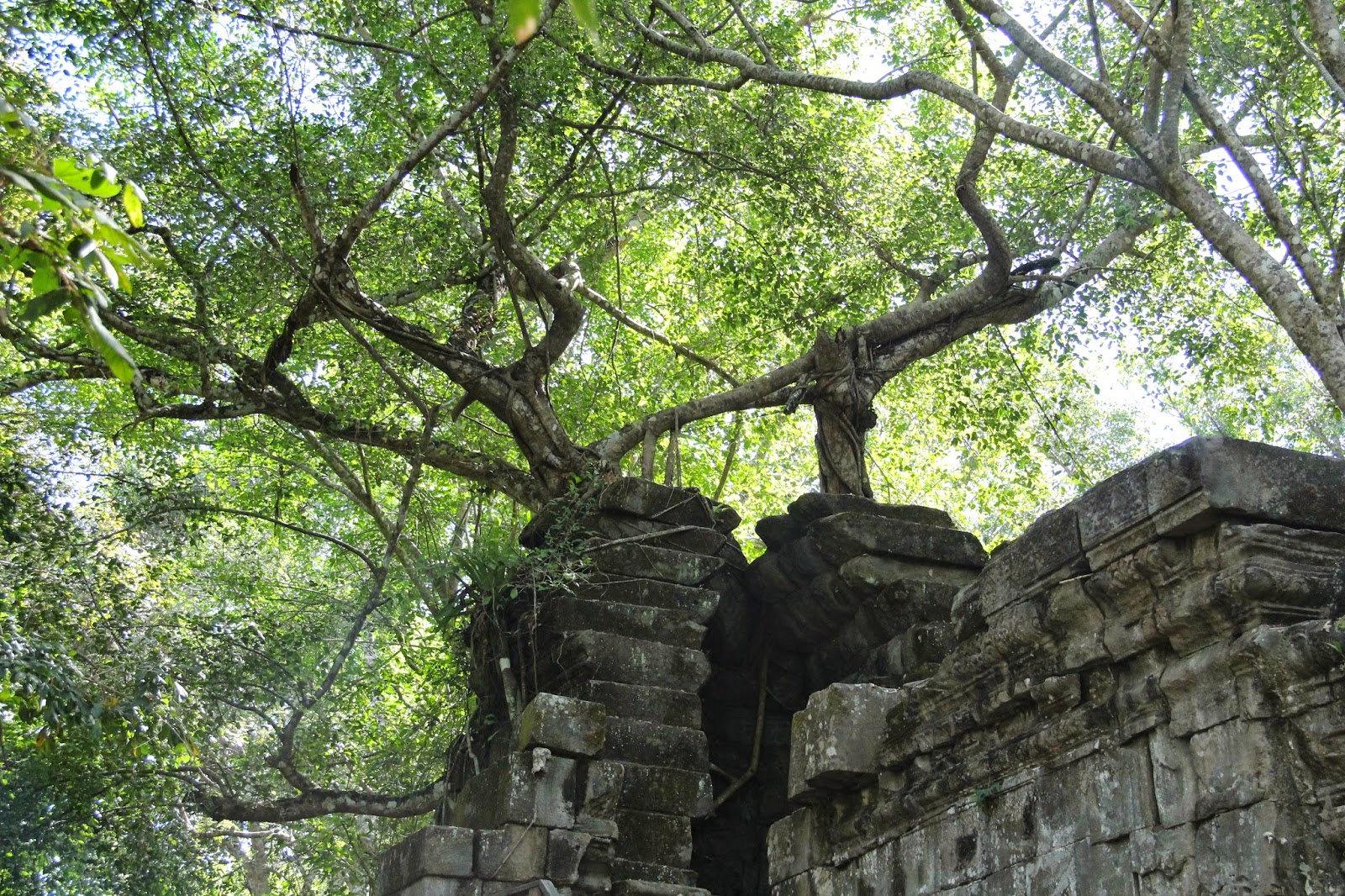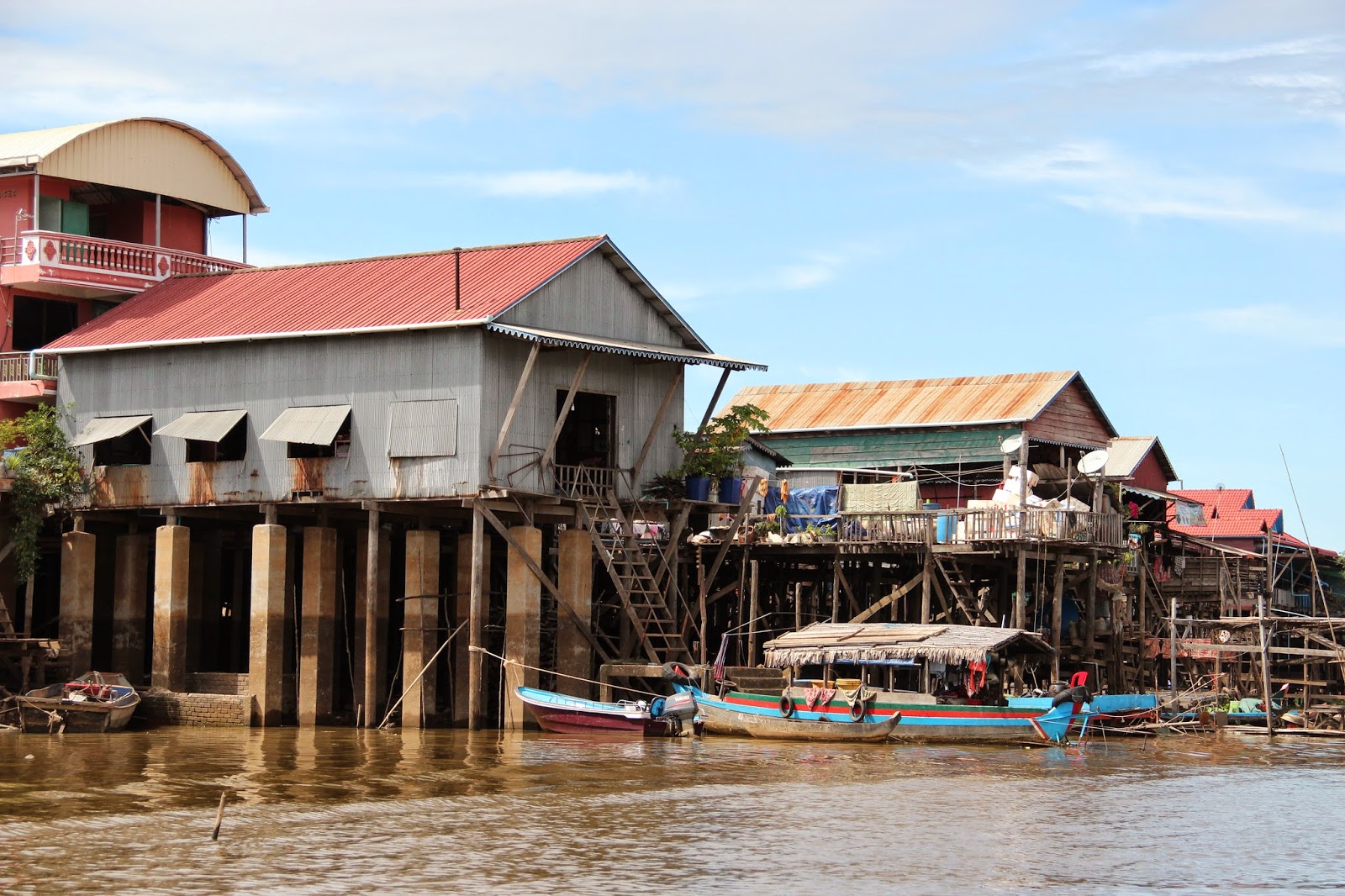Friday, December 5
Met downstairs for the breakfast buffet at 7:00. Large selection including omelet bar, noodle bar, fruits, salads, breads. rice, potatoes, bacon, juices, etc. Pleasant now but very humid and it will near 90 degrees this afternoon.
Our tour guide's name is Bob and yes, it really is Bob. In Khmer language it means "big" and he was a big baby, he said, and got teased a lot about his name when growing up. He is 35 years old and studied at the University. His English was good, though some things were pretty funny - like when the van stopped and he wanted us to move, he'd say "Let's eject!"
Cambodia (and Thailand too) went through various periods of Hindu or Buddhist rulers, so some temples are Hindu, some Buddhist and some a mix of the two. Angkor Wat was built as a Hindu temple and features Shiva as well as other gods and goddesses. Some buddha figures were added later. At its height, the Angkor area was home to one million people and was the capital city of the Khmer area which included present Thailand, Cambodia and parts of Laos.
Angkor consists of a large area and many temples, with Angkor Wat being the largest and most well known. Built between 1113 and 1150 AD, of a combination of Lava Stone and Sandstone, it is surrounded by a moat which provided protection and also a way to get building supplies here. It is a massive three-tiered pyramid crowned by five lotus-like towers. It was eventually abandoned because of drought and then forgotten and left to the jungle until re-discovered by a mahout in the 1970s. Much of the restoration and work is funded by a combination of UNESCO, China, India, Germany and other countries.
 |
| Approaching Angkor Wat over the moat. |
The total population of Cambodia is 15 million and up to 40 million people visit Angkor Wat annually. It is very busy today. Many tourists these days from China, but we have also run into people from France, Indonesia, Holland, Spain, Malaysia, Singapore, and a few other Americans.
We entered across the moat and into the people's entry. There are other entries that were for soldiers, the king, gods and elephants. There are two libraries before you reach the temple. This temple was dedicated to Vishnu, shown here. And there is a large pool where the stone was washed before used in construction. The main temple is up a set of steep stairs, about 80 meters high.
Other than extensive carvings and a few statues, most of the movable items have long ago been plundered. As recently as this year, the US returned quite a few antiquities that it had confiscated and these will be in the National Museum in Phnom Pen.
There are several galleries, like long porch areas, which have thousands of carvings on the walls depicting history, legends, etc. Bob tells us about some of them featuring wars, religious stories, legends, animals, etc. This one shows a god sitting in judgement and sending people either upward to heaven or down to hell.
 |
| One of several galleries with extensive carvings. |
 |
| Bob explaining carvings. |
The next temple we go to is Ta Prohm complex. We enter through the East Gate and as we walk towards the temple we pass this group of men playing music.
They are a landmine band - all have some injury from land mines. This is still a problem in the border areas, though most of the more populated areas have been cleared. Ta Prohm means Brahma Ancestors and Brahma is the Creator God.
Again there are libraries. This temple was built in the late 12th century as a Buddhist temple. It contained the Royal Monastery and Buddhist University. It also has a moat and a pool, with the library located in the middle of the pool. The huge silk cotton tree growing atop the temple is probably 100-200 years old and parts of the complex are intentionally left unrestored, with trees and vines taking over the area. Bob says there are cobras living in the rubble. He tells us that he and his family frequently ate cobra when he was young. (Tastes like chicken - ha!)
Next we drive to Khmer Angkor Kitchen for lunch. Here, as in Thailand, dishes are served as they are ready rather than waiting to serve the entrie table at once. Restaurants provide a nice waiting area for drivers and guides, with hammocks.
After lunch we head to Ankor Thom temple. (Sounds like Uncle Tom). Thom means Banyan tree.
This was built as a Buddhist temple, in the late 12th-early 13th century. There are 49 towers here (54 if you add the entry gate towers) which represent the 54 surrounding counties. It also has some galleries with intricate carvings many of which Bob explained. We see some restoration workers fabricating parts of lion statues. Most of the towers have four faces on them, one on each side which reflects the 4-headed god Brahma.
Back to the hotel around 3:30. Greg and I walked to a local convenience store to get some cash from the ATM. Cambodia uses the riel but prefers US money (for stability) and will give change in US dollars with change less than $1 given in riels. 40,000 riels to $1, so our 1000 riel bill is worth about $.17. The average annual income, per Bob, is about $1,200 or $100/month! (Thailand is about 4x that.)
Bob talked today about Pol Pot, the ruler during the 1970's 80's who massacred millions during his reign, mostly anyone who was educated, and he closed all the schools. He set the country back and it is still struggling to recover. Bob said he didn't start school till he was 10 and when he learned to read he did so with his uncle who was 10 years older. His school was in a house and had about 50 kids of all ages. We pass the infamous "killing fields". Bob said HIV was an issue here for a while, then malaria became a problem. He says both are mostly now controlled with medicines, clinics, mosquito nets, etc. but with all the water it is easy to see why it might be a problem. Now he said the most deaths are from highway accidents.
Showered and rested up and met the group at 6PM for drinks downstairs. Tonight we opted to go to Khmer Kitchen in town, which Greg had read about and got a recommendation from one of the staff here. We take yuk-tuks. It is a busy place, always a good sign, and has good, inexpensive Khmer food. Fresh Spring rolls, Lo Lak Beef, Baked Pumpkin Curry and Arok Fish are some of the specialties we try. I enjoyed the pumpkin curry.
 |
our Lambourgini tuk-tuk, waiting on the sidewalk.
|

The restaurant is near the Old Market and Night Market, so after dinner we wandered through the market area. Many items similar to those in Thailand, though it seems a bit more expensive. Tuk-tuks back to the hotel. At one point they drive onto the sidewalk to let some buses go by on this narrow street. The tuk-tuk (pronounced took-took) drivers have cute names and decorations on their vehicles. The ones we got tonight had "Lambourgini" fancily inscribed on them.
We will meet tomorrow for an outing to another temple, about 50 miles out of town and then to Tonle Sap Lake, the heart of the country.























































